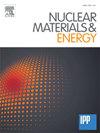Boundary plasma studies for a spherical tokamak with lithium walls
IF 2.3
2区 物理与天体物理
Q1 NUCLEAR SCIENCE & TECHNOLOGY
引用次数: 0
Abstract
Boundary plasma and plasma-material interactions are investigated for magnetised target fusion (MTF) applications. The General Fusion magnetised target fusion technology uses coaxial helicity injection (CHI) start-up which forms a spherical tokamak in a cavity with liquid lithium walls that will subsequently be compressed to fusion conditions Laberge, J. Fusion Energy (2019) The Plasma Injector 3 (PI3) experiment at General Fusion is a non-compressing experiment with solid lithium walls that studies the formation and quasi-steady state operation of a CHI spherical tokamak Carbajal et al. (2023). An explorative study is carried out for wall-limited versus diverted configurations for PI3 using the fluid edge transport code UEDGE. Experimental edge temperature and density profiles from triple Langmuir probes are used to establish realistic temperature and density profiles in UEDGE Rognlien et al. (1992) by adjusting the transport coefficients. In UEDGE, we model the wall-limited plasma via a thin limiter with various insertion depths. It is found that limiter depth and location are key parameters in determining radial profiles and sputtered lithium behaviour. Furthermore, it is found that the total sputtering of the limiter is significantly lower than the sputtering of the wall in some of the limiter configurations studied. Lithium ions and neutral behaviour are compared between limited and diverted configurations.
求助全文
约1分钟内获得全文
求助全文
来源期刊

Nuclear Materials and Energy
Materials Science-Materials Science (miscellaneous)
CiteScore
3.70
自引率
15.40%
发文量
175
审稿时长
20 weeks
期刊介绍:
The open-access journal Nuclear Materials and Energy is devoted to the growing field of research for material application in the production of nuclear energy. Nuclear Materials and Energy publishes original research articles of up to 6 pages in length.
 求助内容:
求助内容: 应助结果提醒方式:
应助结果提醒方式:


